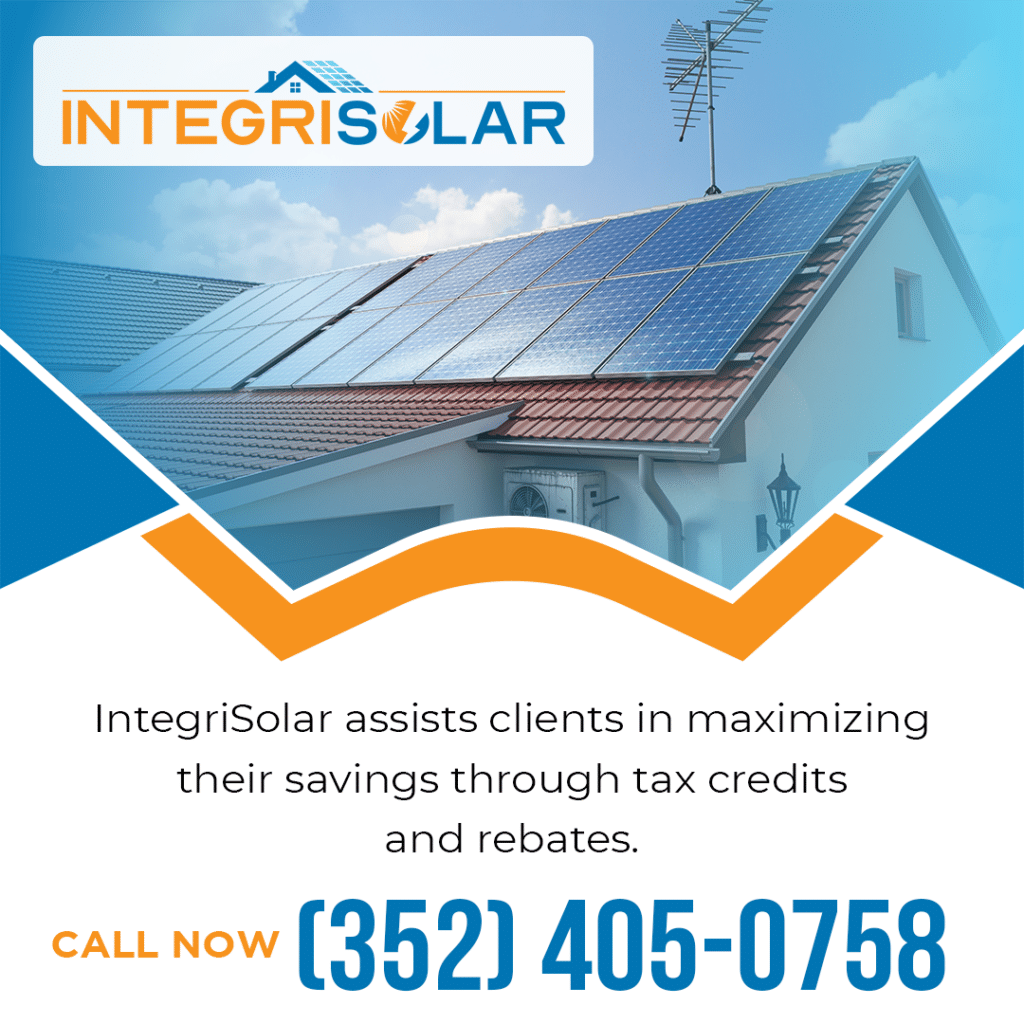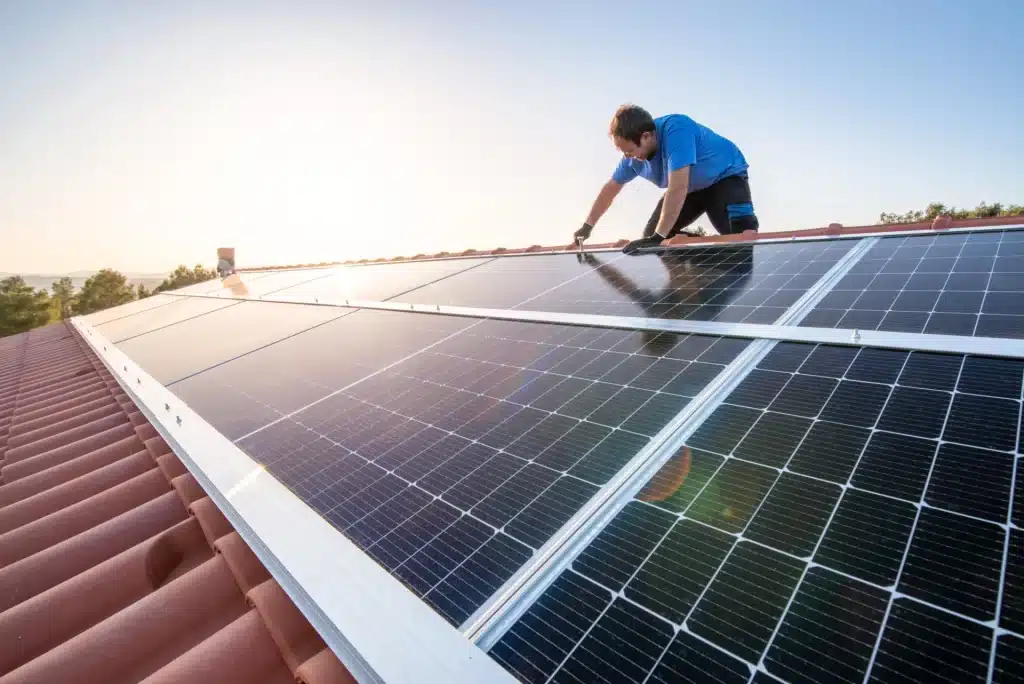We’ve all noticed the decrease in solar panel prices, but have you ever wondered why? In this article, IntegriSolar, the premier solar installation company, will explore the reasons behind the affordability of solar panels today compared to the past. Technological advancements, increased production efficiency, and reductions in manufacturing costs have all played a significant role. Government incentives, subsidies, and growing market competition have also contributed to the lower prices. Let’s dive in and uncover the secrets behind this solar revolution.
Key Takeaways
- Technological advancements and increased production efficiency have led to more efficient solar cell technologies, increased electricity generation from the same amount of sunlight, reduced overall installation cost, and streamlined production processes.
- Reduction in manufacturing costs has been achieved through advances in manufacturing technology, streamlined processes, reduced waste, economies of scale from increased demand, and sourcing materials from low-cost regions.
- Government incentives and subsidies, such as investment tax credits, subsidies and grants for research and development, and feed-in tariffs, have significantly driven down the cost of solar panels and increased demand.
- Growing competition in the market has resulted in constant innovation and development of new technologies, higher quality panels at lower cost, increased affordability and accessibility for consumers, and market forces driving down prices.
Technological Advancements in Solar Panel Manufacturing
With the advancements in technology, we have seen a significant decrease in the cost of solar panels. Over the years, solar panel manufacturers have made great strides in improving the efficiency and affordability of their products. These technological advancements have revolutionized the solar industry, making solar panels more accessible to consumers. At IntegriSolar, we stay at the forefront of these innovations, ensuring that our clients benefit from the latest advancements in solar technology while making sustainable energy solutions more attainable for everyone.
A pivotal factor contributing to the decline in solar panel prices is the evolution of more efficient solar cell technologies. Manufacturers have successfully enhanced the efficiency of solar cells, enabling them to produce more electricity from the same amount of sunlight. Consequently, consumers can now achieve their energy needs with fewer solar panels, reducing overall installation costs.
Moreover, advancements in manufacturing processes have played a crucial role in driving down the cost of solar panels. Manufacturers have implemented strategies to streamline production, increase automation, and minimize material waste. These improvements have yielded economies of scale, leading to lower manufacturing costs and, ultimately, a decrease in the price of solar panels.
Additionally, governmental incentives and subsidies, beyond technological progress, play a significant role in alleviating the costs associated with solar panels. Many nations have instituted policies and initiatives to promote the adoption of solar energy, offering financial incentives and tax credits to individuals and businesses investing in solar panel installations. These incentives mitigate the initial financial burden, making solar panels more financially accessible and affordable for consumers.

Solar Panels: Increased Production Efficiency
We have successfully achieved cost reductions for solar panels through heightened production efficiency. Manufacturers have streamlined production processes with technological advancements, resulting in substantial cost savings. The development of automated manufacturing systems has increased efficiency, reducing the reliance on manual labor, minimizing the potential for human error, and boosting production speed and accuracy. IntegriSolar is dedicated to harnessing these technological strides to offer clients cost-effective, cutting-edge solar solutions.
In addition, enhanced supply chain management has been instrumental in cost reduction. Manufacturers have optimized procurement processes, ensuring a consistent supply of raw materials and components at more affordable prices. Manufacturers have minimized waste and reduced storage costs by creating strategic partnerships with suppliers and adopting just-in-time inventory management techniques.
Furthermore, technological progress has helped create more efficient solar panel designs. Using thinner and lighter materials has increased the panels’ ease of handling and installation and contributed to lower manufacturing costs. Cell efficiency and module design innovations have elevated overall energy output, making solar panels more cost-effective for consumers.
Reduction in Manufacturing Costs of Solar Panels
The significant decrease in manufacturing costs has been a major factor in the current affordability of solar panels. As the cost of producing solar panels has reduced, the overall price of the technology has become more accessible to consumers and within the reach of the average person.
At IntegriSolar, we make cutting-edge solar technology affordable, empowering a wider range of consumers to embrace sustainable energy solutions for their homes. Here are four key reasons why manufacturing costs have been reduced:
1. Technological advancements: Advances in manufacturing technology have greatly improved the efficiency and productivity of solar panel production. This has led to streamlined processes, reduced waste, and lower labor costs. With better automation and equipment, manufacturers can produce panels faster and more precisely, resulting in cost savings.
2. Economies of scale: As the demand for solar panels has increased, manufacturers have benefited from economies of scale. Bulk purchasing materials and components have allowed them to negotiate better prices and reduce production costs. Additionally, expanding production facilities has led to higher production volumes, spreading fixed costs over larger units.
3. Improved supply chain management: Manufacturers have optimized their supply chains by sourcing materials and components from low-cost regions. This, in turn, has reduced transportation costs and allowed for more efficient inventory management. By working closely with suppliers and implementing optimized production practices, manufacturers have reduced costs throughout the entire manufacturing process.
4. Government incentives and policies: These policies and incentives have significantly reduced solar panel costs. Initiatives promoting renewable energy, such as subsidies, tax credits, and grants, have served as powerful incentives for manufacturers to invest in research and development. This investment has led to research and innovations that enhance the efficiency of solar panels and contribute to lowering production costs. Furthermore, supportive policies have created an environment encouraging market competition and compelling manufacturers to find more cost-effective solar panel production methods. These government-driven initiatives have played a main role in making solar panel costs more accessible and promoting adopting renewable energy solutions.
Government Incentives and Subsidies
Government incentives and subsidies have played a crucial role in reducing the cost of solar panel manufacturing. The financial incentives governments provide worldwide have helped promote the adoption of solar energy and drive down the prices of solar panels.
One of the most significant government incentives is the investment tax credit (ITC), which allows solar panel owners to deduct a percentage of their installation costs from their federal taxes. For example, the ITC offers up to 30% tax credit in the United States for residential and commercial solar installations. This tax credit has encouraged more individuals and businesses to invest in solar panels, leading to increased demand and economies of scale that have contributed to lower manufacturing costs.
Furthermore, many governments provide subsidies and grants to support research and development in the solar industry. These funds help companies develop more efficient manufacturing processes and improve the quality of solar panels. By investing in innovation, governments have helped drive technological advancements that have made solar panels cheaper and more accessible.
Moreover, certain governments provide Feed-in Tariffs (FITs), ensuring a predetermined payment for each unit of electricity generated by solar panels. FITs establish a reliable income source for solar panel owners, enhancing the appeal and financial viability of investing in solar energy. This backing has surged the demand for solar panels and sparked competition among manufacturers, fostering additional cost reductions in the industry.
Growing Competition in the Solar Panel and Solar Energy Market
As solar energy gains greater popularity and manufacturing costs decrease, the solar panel market experiences a consistent rise in competition. This heightened competition, influenced by innovations and efficiency improvements, has notably affected the affordability and accessibility of solar panels for consumers. IntegriSolar, in particular, plays a pivotal role in this landscape, contributing to the ongoing evolution of the market and making strides towards reducing solar panel costs, ultimately benefiting consumers. Here are four reasons why growing competition in the market is driving down the prices of solar panels:
1. Advancements in Technology: As more companies enter the solar panel market, they constantly strive to develop new, more efficient technologies. This competition pushes manufacturers to innovate and improve their products, resulting in higher-quality panels at lower costs.
2. Economies of Scale: With the growing demand for solar panels, manufacturers can produce them in larger quantities. This allows them to benefit from economies of scale, meaning the cost per unit decreases as production volume increases. As a result, solar panel prices have been steadily declining.
3. Increased Efficiency: The competition in the market has also led to improvements in the efficiency of solar panels. Manufacturers are investing in research and development to increase the energy conversion efficiency of their products. Higher efficiency means more energy can be generated from the same surface area, making solar panels more cost-effective.
4. Global Market Expansion: Solar panel manufacturers are not only competing locally but also on a global scale. This global competition forces manufacturers to optimize production processes, reduce costs, and offer competitive prices. The global market expansion has created opportunities for consumers to access solar panels at lower prices.
Global Shift Towards Sustainable Energy
In the current global landscape, the growing awareness of the imperative need for sustainable energy solutions has ushered in a transformative shift towards renewable sources, with solar energy at the forefront. IntegriSolar, your trusted solar energy company in Ocala, FL, is actively promoting sustainable practices and contributing to reducing solar panel costs.
As the world recognizes the urgency of addressing environmental concerns, the demand for clean energy solutions has surged, prompting intensified research, innovation, and increased production of solar panels. The heightened global awareness of climate change and the necessity for sustainable energy have created a ripple effect, pressuring governments, businesses, and individuals to adopt eco-friendly alternatives.
With this paradigm shift, solar panel prices have experienced a notable decline. IntegriSolar’s commitment to making advanced solar technology available to all has contributed to this positive trend. The increased adoption of sustainable energy solutions, propelled by a collective global understanding of their necessity, has created economies of scale, making solar panels more accessible to a broader population.

In this era where sustainable energy is not merely a choice but a necessity, IntegriSolar stands as a beacon, driving positive change and fostering a future where solar panel costs continue to decrease, paving the way for a more sustainable and environmentally conscious world.
Frequently Asked Questions
Can Solar Panels Generate Electricity at Night or on Cloudy Days?
Solar panels, including those from IntegriSolar, cannot generate electricity during nighttime or on cloudy days since their functionality hinges on sunlight and the photovoltaic effect. Nevertheless, ongoing advancements in solar technology have enhanced panel efficiency, enabling them to generate electricity even in low-light conditions. This progress contributes to solar panels’ overall effectiveness and reliability as a renewable energy source, addressing limitations related to varying light conditions and further optimizing their performance.
What Are the Environmental Impacts of Solar Panel Manufacturing?
When evaluating the environmental implications of solar panel manufacturing, particularly concerning IntegriSolar and solar panel prices, it is crucial to examine the entire lifecycle of these energy systems. This analysis encompasses raw material extraction to disposal, considering energy consumption, water usage, and greenhouse gas emissions during production. Despite these considerations, the environmental advantages of solar panels outweigh the impacts associated with traditional energy sources. Moreover, ongoing technological advancements and improvements in economies of scale have reduced the cost of solar panels, rendering them more affordable and accessible to a broader population.
Are There Any Drawbacks or Limitations to Using Solar Panels?
While there are considerations to consider when using solar panels, such as the initial purchase and installation costs, it’s worth noting that these costs have been steadily decreasing over time. Although solar panels rely on sunlight and may experience limitations during cloudy days or at night, ongoing technological advancements are actively addressing these challenges. Additionally, factors like location and shading affecting efficiency are being continually addressed, enhancing the overall positive outlook for solar panels. IntegriSolar emphasizes that with each advancement, solar energy becomes an increasingly viable and accessible choice, highlighting the positive trajectory of renewable energy options.
How Long Do Solar Panels Typically Last Before Needing to Be Replaced?
With IntegriSolar, solar panels exhibit a typical lifespan of approximately 25 to 30 years before replacement may be necessary. It’s essential to recognize that their efficiency may experience a gradual decline over time, influenced by weather conditions and maintenance practices. To enhance their longevity, regular inspections and cleanings are recommended. Notably, advancements in technology and manufacturing processes championed by IntegriSolar have significantly improved the durability and efficiency of solar panels, contributing to their extended lifespan. This commitment to innovation ensures that solar panels from IntegriSolar remain a reliable and enduring renewable energy solution.
Can Solar Panels Be Installed on All Types of Roofs?
Certainly! IntegriSolar specializes in installing solar panels on various flat or sloped roof types. The roof design choice influences the installation process and the type of mounting system required. For optimal results, engaging with a professional solar installer from IntegriSolar is crucial. Our experts will assess the suitability of your roof for solar panel installation, considering factors such as orientation, shading, and structural integrity. This personalized approach ensures a successful and efficient solar installation tailored to your specific roof characteristics and energy needs.
Conclusion
In conclusion, the diminishing cost of solar panels can be attributed to various factors, such as technological advancements, increased production efficiency, reduction in manufacturing costs, government incentives and subsidies, and growing competition in the market. These collaborative initiatives have played a pivotal role in making solar panels more affordable and accessible for individuals and businesses alike. As a result, solar energy, backed by solar installation companies like IntegriSolar, is rapidly becoming a more viable and sustainable option for meeting diverse energy needs.

